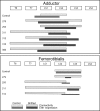An early broad competence of motoneurons to express ER81 is later sculpted by the periphery
- PMID: 15525764
- PMCID: PMC6730243
- DOI: 10.1523/JNEUROSCI.3409-04.2004
An early broad competence of motoneurons to express ER81 is later sculpted by the periphery
Abstract
The ETS transcription factor ER81 is expressed in sensory neurons and motoneurons that innervate the adductor and femorotibialis muscles in chick hindlimb and is essential for the development of monosynaptic connections between these two populations of neurons. Neurons need a signal(s) from limb bud mesoderm to initiate ER81 expression. It is not known whether the mature expression pattern arises because adductor and femorotibialis motoneurons are uniquely competent to respond to peripheral signals and express ER81, or whether all motoneurons are competent to express ER81, but normally only adductor and femorotibialis motoneurons are exposed to the requisite activating signal. To investigate these possibilities, we examined ER81 expression in motoneurons that encountered limb tissue surgically mismatched with their target identity at stages after motor pool identities are established. We found that ER81 expression was not invariably linked to motor pool identity or target innervation and was more malleable in later-born femorotibialis motoneurons than in earlier-born adductor motoneurons. We also found that ER81 expression is regulated differently in sensory neurons and motoneurons. Most striking was the observation that motoneurons caudal to the normal adductor and femorotibialis pools could express ER81 when exposed to the appropriate peripheral signals, although this competence did not extend through the entire lumbosacral (LS) region. Thus, it appears that a prepattern of competence to express ER81 is established in early LS motoneurons, most likely in concert with their target identity, and that the expression domains of motoneurons are subsequently refined by peripheral signals at later stages.
Figures








Similar articles
-
Functionally related motor neuron pool and muscle sensory afferent subtypes defined by coordinate ETS gene expression.Cell. 1998 Oct 30;95(3):393-407. doi: 10.1016/s0092-8674(00)81770-5. Cell. 1998. PMID: 9814709
-
A critical period for the specification of motor pools in the chick lumbosacral spinal cord.Development. 1996 Feb;122(2):659-69. doi: 10.1242/dev.122.2.659. Development. 1996. PMID: 8625817
-
Muscle sensory innervation patterns in embryonic chick hindlimbs following dorsal root ganglion reversal.Dev Biol. 1997 Jun 1;186(1):27-35. doi: 10.1006/dbio.1997.8583. Dev Biol. 1997. PMID: 9188750
-
Development of neuromuscular connections: guidance of motoneuron axons to muscles in the embryonic chick hindlimb.Ciba Found Symp. 1988;138:97-115. doi: 10.1002/9780470513675.ch7. Ciba Found Symp. 1988. PMID: 3058436 Review.
-
Development of spinal motor networks in the chick embryo.J Exp Zool. 1992 Mar 1;261(3):261-73. doi: 10.1002/jez.1402610306. J Exp Zool. 1992. PMID: 1629659 Review.
Cited by
-
Divergence between motoneurons: gene expression profiling provides a molecular characterization of functionally discrete somatic and autonomic motoneurons.Physiol Genomics. 2006 Feb 14;24(3):276-89. doi: 10.1152/physiolgenomics.00109.2005. Epub 2005 Nov 29. Physiol Genomics. 2006. PMID: 16317082 Free PMC article.
-
Retinoid signaling is involved in governing the waiting period for axons in chick hindlimb.Dev Biol. 2008 Sep 1;321(1):216-26. doi: 10.1016/j.ydbio.2008.06.021. Epub 2008 Jun 21. Dev Biol. 2008. PMID: 18602384 Free PMC article.
References
-
- Arber S, Ladle DR, Lin JH, Frank E, Jessell TM (2000) ETS gene Er81 controls the formation of functional connections between group Ia sensory afferents and motor neurons. Cell 101: 485-498. - PubMed
-
- Birren SJ, Lo L, Anderson DJ (1993) Sympathetic neuroblasts undergo a developmental switch in trophic dependence. Development 119: 597-610. - PubMed
-
- Dasen JS, Liu JP, Jessell TM (2003) Motor neuron columnar fate imposed by sequential phases of Hox-c activity. Nature 425: 926-933. - PubMed
-
- Ensini M, Tsuchida TN, Belting H, Jessell TM (1998) The control of rostrocaudal pattern in the developing spinal cord: specification of motor neuron subtype identity is initiated by signals from paraxial mesoderm. Development 125: 969-982. - PubMed
Publication types
MeSH terms
Substances
Grants and funding
LinkOut - more resources
Full Text Sources
Other Literature Sources
